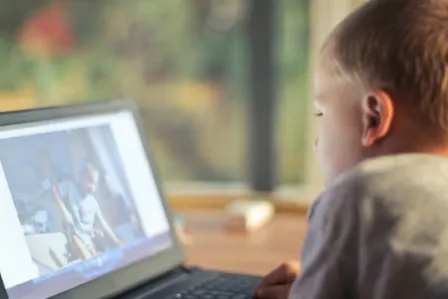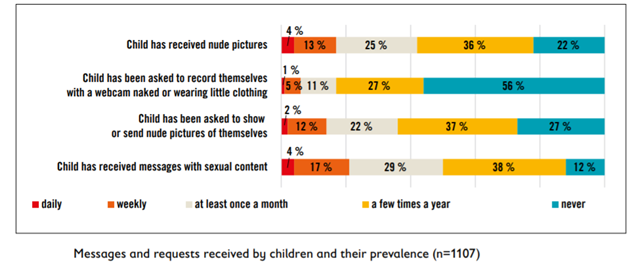Save the Children Finland’s new report on online grooming for sexual purposes is now available in English. The report, “Grooming in the eyes of a child – a report on the experiences of 11−17-year-old children on online grooming”, is based on answers from 1,762 children, gathered in February and March 2021.

According to the report, grooming experiences are rather common among the children who responded to the survey. Of the children, 62 per cent (n=1,069) had been contacted online by a person they knew or suspected to be an adult or at least five years older than them. For this question, children were not asked to define the nature of the contact. However, when asked about messages with sexual content, 17 per cent (n=190) received them from adults every week and 29 per cent (n=320) at least once a month. Only eight per cent (n=64) of girls had never received messages with sexual content online, whereas 39 per cent (n=51) of boys had never received them.

Image credits: Save the Children Finland
The children were asked whether or not they had disclosed their grooming experience and, if they had disclosed, who they had told. A third (33 per cent, n=333) had not told anyone. The majority of the children who had disclosed had told their friend (93 per cent, n=617), 18 per cent (n=120) had told their mother, and only 12 per cent (n=84) had told the authorities (for example, a school nurse, social worker, or the police). If a child had not told anyone, the most common reason for this was that they did not feel what had happened was anything serious (75 per cent, n=244). Almost half did not believe that telling someone would help (45 per cent, n=148).
Overall, based on the report, children feel they have knowledge of grooming and that they can identify someone attempting to groom them for sexual purposes online. However, they do not see grooming as anything serious and often do not tell an adult. Many children know to block the person attempting to groom them (78 per cent, n=762), but few report what has happened. This shows a clear need for information on how to act in a grooming situation, who to report to, and where to find help.
The full report includes an analysis of the results and recommendations.
Find out more about the work of the Finnish Safer Internet Centre, including its awareness raising, helpline, hotline and youth participation services – or find similar information for Safer Internet Centres throughout Europe.
Save the Children Finland’s new report on online grooming for sexual purposes is now available in English. The report, “Grooming in the eyes of a child – a report on the experiences of 11−17-year-old children on online grooming”, is based on answers from 1,762 children, gathered in February and March 2021.

According to the report, grooming experiences are rather common among the children who responded to the survey. Of the children, 62 per cent (n=1,069) had been contacted online by a person they knew or suspected to be an adult or at least five years older than them. For this question, children were not asked to define the nature of the contact. However, when asked about messages with sexual content, 17 per cent (n=190) received them from adults every week and 29 per cent (n=320) at least once a month. Only eight per cent (n=64) of girls had never received messages with sexual content online, whereas 39 per cent (n=51) of boys had never received them.

Image credits: Save the Children Finland
The children were asked whether or not they had disclosed their grooming experience and, if they had disclosed, who they had told. A third (33 per cent, n=333) had not told anyone. The majority of the children who had disclosed had told their friend (93 per cent, n=617), 18 per cent (n=120) had told their mother, and only 12 per cent (n=84) had told the authorities (for example, a school nurse, social worker, or the police). If a child had not told anyone, the most common reason for this was that they did not feel what had happened was anything serious (75 per cent, n=244). Almost half did not believe that telling someone would help (45 per cent, n=148).
Overall, based on the report, children feel they have knowledge of grooming and that they can identify someone attempting to groom them for sexual purposes online. However, they do not see grooming as anything serious and often do not tell an adult. Many children know to block the person attempting to groom them (78 per cent, n=762), but few report what has happened. This shows a clear need for information on how to act in a grooming situation, who to report to, and where to find help.
The full report includes an analysis of the results and recommendations.
Find out more about the work of the Finnish Safer Internet Centre, including its awareness raising, helpline, hotline and youth participation services – or find similar information for Safer Internet Centres throughout Europe.
- < Previous article
- Next article >












